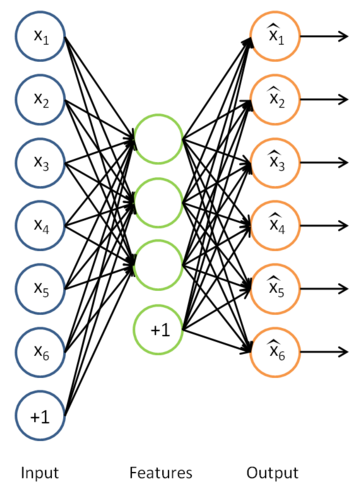自编码器是一个三层的feed-forward神经网络模型,输入层经过隐含层的特征表示后再重构出跟输入层逼近的输出层,中间的隐含层是特征表示层,表示对输入层学习到的特征,这些特征可能更好地表示了数据,如果用学到的特征来训练数据分类或回归可能学习效果更好,于是就有了自我学习和无监督特征学习。
如果我们有很多的未标注数据,那就更好了,我们可以用自编码器学习特征表示,然后用学到的特征表示对已标注数据提取特征,再用机器学习算法比如softmax regression进行训练、预测,即先经过无监督的特征学习,然后再经过有监督的学习。未标注数据与已标注数据来自同一分布时就是半监督学习,来自不同分布就是无监督学习,比如我们的目标是要区分摩托车和汽车,如果未标注数据也是摩托车或汽车,那么这个问题就是半监督学习,如果不是则是自我学习。
自编码的网络结构如下:
通过自编码器得到特征表示的模型参数W1和b1,我们就可以用W1和b1对已标注数据进行特征提取,即算出它们的激活值。
实验数据也是MNIST数据集,这次把5-9类的数据作为无标注数据学习特征表示,然后在0-4类的数据中分为训练集和测试集来运行模型,实验结果的预测准确率为98.32%,而直接用图像像素作为输入得到准确率为96.74%。
%% CS294A/CS294W Self-taught Learning Exercise
% Instructions
% ------------
%
% This file contains code that helps you get started on the
% self-taught learning. You will need to complete code in feedForwardAutoencoder.m
% You will also need to have implemented sparseAutoencoderCost.m and
% softmaxCost.m from previous exercises.
%
%% ======================================================================
% STEP 0: Here we provide the relevant parameters values that will
% allow your sparse autoencoder to get good filters; you do not need to
% change the parameters below.
inputSize = 28 * 28;
numLabels = 5;
hiddenSize = 200;
sparsityParam = 0.1; % desired average activation of the hidden units.
% (This was denoted by the Greek alphabet rho, which looks like a lower-case "p",
% in the lecture notes).
lambda = 3e-3; % weight decay parameter
beta = 3; % weight of sparsity penalty term
maxIter = 400;
%% ======================================================================
% STEP 1: Load data from the MNIST database
%
% This loads our training and test data from the MNIST database files.
% We have sorted the data for you in this so that you will not have to
% change it.
% Load MNIST database files
mnistData = loadMNISTImages('mnist/train-images-idx3-ubyte');
mnistLabels = loadMNISTLabels('mnist/train-labels-idx1-ubyte');
% Set Unlabeled Set (All Images)
% Simulate a Labeled and Unlabeled set
labeledSet = find(mnistLabels >= 0 & mnistLabels <= 4);
unlabeledSet = find(mnistLabels >= 5); %5-9类作为无标签数据集用来学习特征表示
%已标注数据分一半分别用于训练softmax和测试
numTrain = round(numel(labeledSet)/2);
trainSet = labeledSet(1:numTrain);
testSet = labeledSet(numTrain+1:end);
unlabeledData = mnistData(:, unlabeledSet);
trainData = mnistData(:, trainSet);
trainLabels = mnistLabels(trainSet)' + 1; % Shift Labels to the Range 1-5
testData = mnistData(:, testSet);
testLabels = mnistLabels(testSet)' + 1; % Shift Labels to the Range 1-5
% Output Some Statistics
fprintf('# examples in unlabeled set: %d\n', size(unlabeledData, 2));
fprintf('# examples in supervised training set: %d\n\n', size(trainData, 2));
fprintf('# examples in supervised testing set: %d\n\n', size(testData, 2));
%% ======================================================================
% STEP 2: Train the sparse autoencoder
% This trains the sparse autoencoder on the unlabeled training
% images.
% Randomly initialize the parameters
theta = initializeParameters(hiddenSize, inputSize);
%% ----------------- YOUR CODE HERE ----------------------
% Find opttheta by running the sparse autoencoder on
% unlabeledTrainingImages
opttheta = theta;
%用minFunc里的L-BFGS算法训练sparse autoencoder的模型,要用到sparse autoencoder的计算损失的代码
addpath minFunc/
options.Method = 'lbfgs';
options.maxIter = 400;
options.display = 'on';
[opttheta, cost] = minFunc( @(p) sparseAutoencoderCost(p, ...
inputSize, hiddenSize, ...
lambda, sparsityParam, ...
beta, unlabeledData), ...
theta, options);
%% -----------------------------------------------------
% Visualize weights
W1 = reshape(opttheta(1:hiddenSize * inputSize), hiddenSize, inputSize);
display_network(W1');
%%======================================================================
%% STEP 3: Extract Features from the Supervised Dataset
%
% You need to complete the code in feedForwardAutoencoder.m so that the
% following command will extract features from the data.
trainFeatures = feedForwardAutoencoder(opttheta, hiddenSize, inputSize, ...
trainData);
testFeatures = feedForwardAutoencoder(opttheta, hiddenSize, inputSize, ...
testData);
%%======================================================================
%% STEP 4: Train the softmax classifier
softmaxModel = struct;
%% ----------------- YOUR CODE HERE ----------------------
% Use softmaxTrain.m from the previous exercise to train a multi-class
% classifier.
% Use lambda = 1e-4 for the weight regularization for softmax
% You need to compute softmaxModel using softmaxTrain on trainFeatures and
% trainLabels
%softmax训练过程
options.maxIter = 100;
lambda = 1e-4;
inputSize = hiddenSize;
softmaxModel = softmaxTrain(inputSize, 5, lambda, ...
trainFeatures, trainLabels, options);
%% -----------------------------------------------------
%%======================================================================
%% STEP 5: Testing
%% ----------------- YOUR CODE HERE ----------------------
% Compute Predictions on the test set (testFeatures) using softmaxPredict
% and softmaxModel
%用到softmax练习中的预测函数
[pred] = softmaxPredict(softmaxModel, testFeatures);
acc = mean(pred(:) == testLabels(:));
fprintf('Accuracy: %0.3f%%\n', acc*100);
%% -----------------------------------------------------
% Classification Score
fprintf('Test Accuracy: %f%%\n', 100*mean(pred(:) == testLabels(:)));
% (note that we shift the labels by 1, so that digit 0 now corresponds to
% label 1)
%
% Accuracy is the proportion of correctly classified images
% The results for our implementation was:
%
% Accuracy: 98.3%
%
%
参考:
http://ufldl.stanford.edu/wiki/index.php/Self-Taught_Learning_to_Deep_Networks

























 7556
7556











 被折叠的 条评论
为什么被折叠?
被折叠的 条评论
为什么被折叠?








